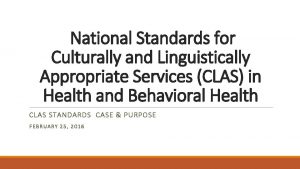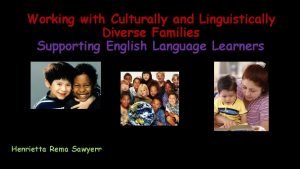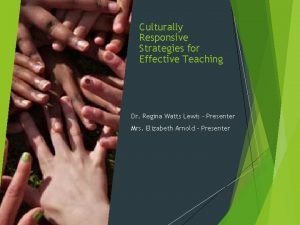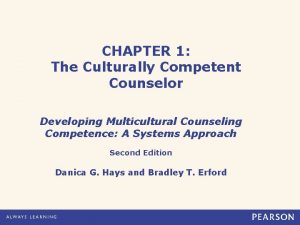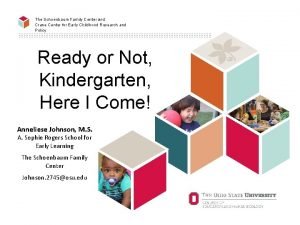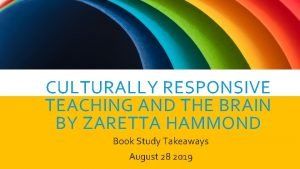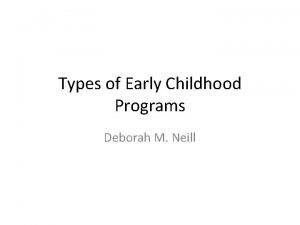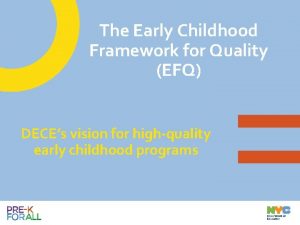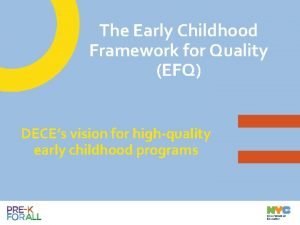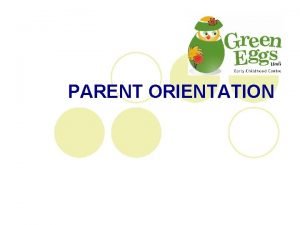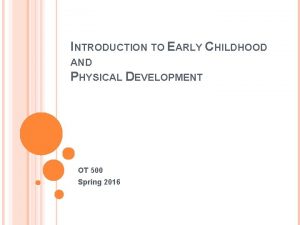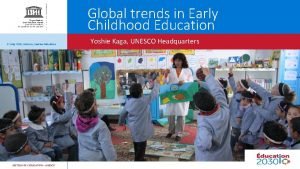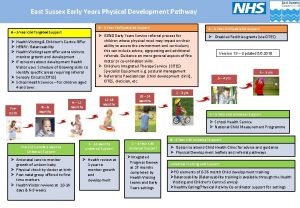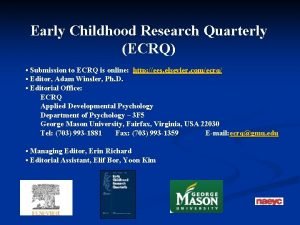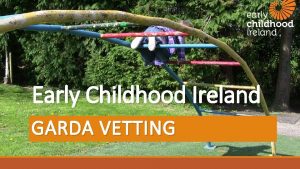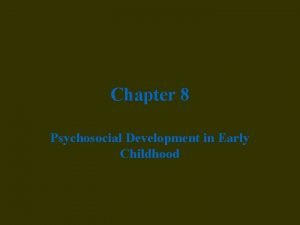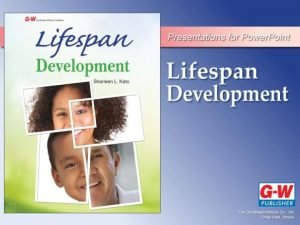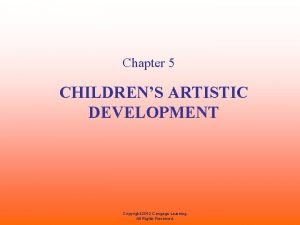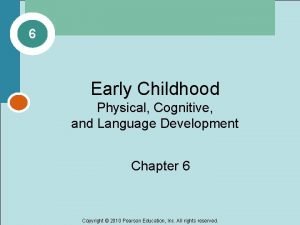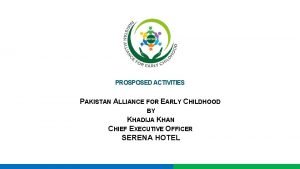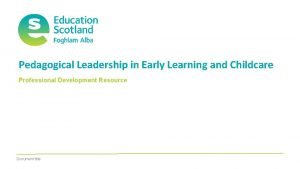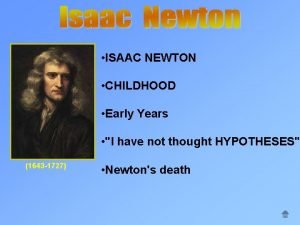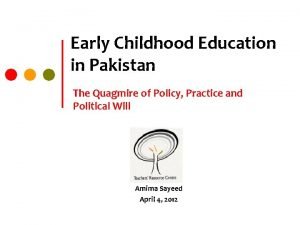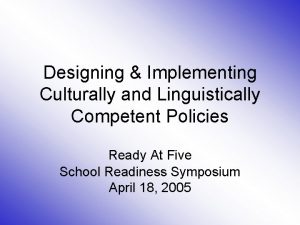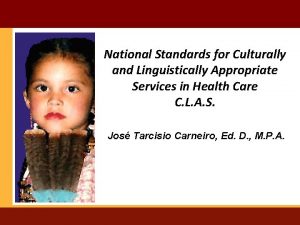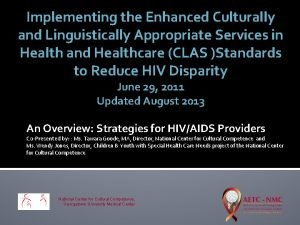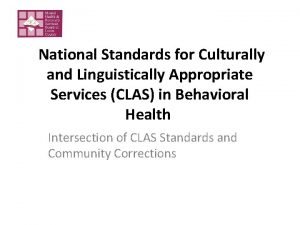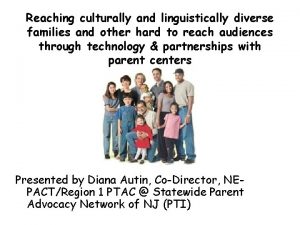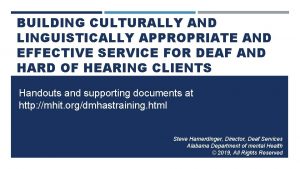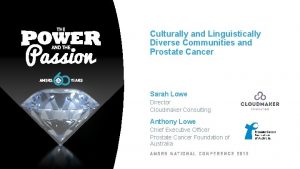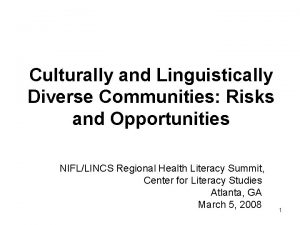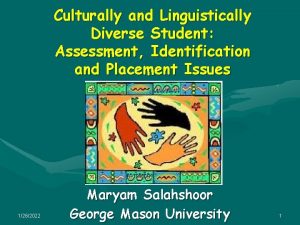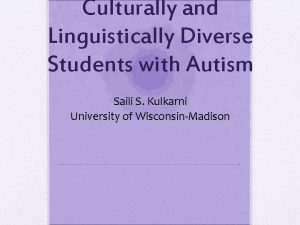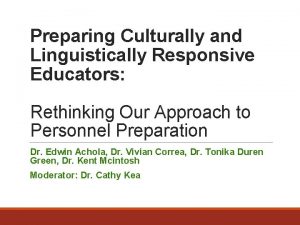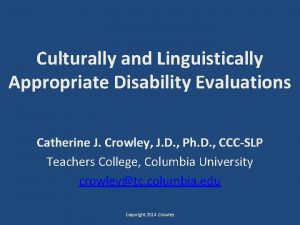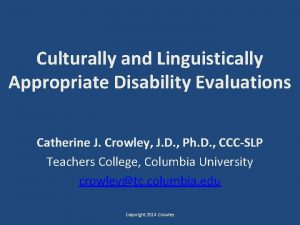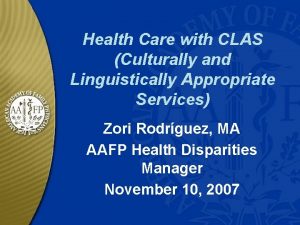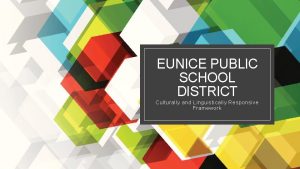Culturally and Linguistically Competent Services In Early Childhood





























- Slides: 29

Culturally and Linguistically Competent Services In Early Childhood Programs “Most cultural exploration begins with the annoyance of being lost. ” Edward T. Hall, Beyond Culture, 1976 1

Agenda/Objectives School Readiness Symposium Ready At Five, April 18, 2005 n Raise awareness of the cultural context of family and community n Reflect upon personal cultural journey n Explore ethnographic strategies for learning about culture n Identify resources for continued learning and practice implementation Hepburn, GUCCHD April 2005 2

The 7 Habits of Highly Effective Culturally and Linguistically Competent Programs n n n Offer parents opportunities for sharing cultural perspectives Staff represents diversity of community and/or appreciates diversity Cultural continuity present in care Honor languages spoken by children in care Traditions, customs, and home lives of children reflected in setting Hepburn, GUCCHD April 2005 3

Curriculum or program helps children understand/appreciate differences n Teachers prepared to help children understand differences n Hepburn, GUCCHD April 2005 4

School Readiness n Ready Child – Physically well – Trusting and selfconfident – Eager to learn – Good communication – Knowledge base n Ready Schools – – Family-centered Child-focused State-of-the art practices Culturally competent Hepburn, GUCCHD April 2005 n In Maryland – Maryland Model for School Readiness – Work Sampling System • • • Staff development Assessment Instruction Family communication Collaboration/coordination among programs – Increasing Diversity – Promising Practices 5

Staff Challenges and Strengths n What are the challenges of preparing staff for working with diverse children and families? n What are staff qualities and strengths that support working toward cultural and linguistic competence? Hepburn, GUCCHD April 2005 6

The Cultural Context of Family and Community A child’s “first world” n Foundation of relationships n Parent belief systems and modes of parent-child interaction n Learning and language development n Generational transfer n Child rearing practices n The role of community n Hepburn, GUCCHD April 2005 7

The Power of Family Context n What did your family customarily do for you when you were sick and had a cold as a child? n What do you do now when you or your children have a cold today? Hepburn, GUCCHD April 2005 8

The Cultural Context of Family and Community n Identity n Child Formation Development n Language Hepburn, GUCCHD April 2005 9

The Cultural Context of Family and Community As a group, read the scenario related to your table’s developmental issue and identify: Cultural connections that support the child’s development in the context of family and community. 2. Challenges that caregivers or providers may face in understanding the cultural context. 3. Potential pitfalls if the cultural context is not recognized and supported. 1. Hepburn, GUCCHD April 2005 10

Identity Formation Alejandra Five year-old Alejandra is excited as her family prepares for a visit from her Abuelitos (grandparents) from Mexico. Her mother and Tias (aunts) stay up late the night before, peeling garlic, roasting chiles, toasting sesame and peanuts to make delicious mole (a spicey sauce) for their parents. Breathing in the spices makes Alejandra feel a little thrill – she already recognizes these as smells of a special occasion. Her father picks some of the plumpest nopales (cactus leaves) he has grown in the backyard for a salad. Alejandara’s mother hands her a bowl of washed tomatoes to take to her father. They have invited all their relatives and friends to tomorrow’s gathering in honor of their parents. Pulido-Tobiassen, D. & Gonzalez-Mena, J. A Place to Begin, California Tomorrow, 1999 11

Identity Formation n Cultural Connections • Sense of belonging, and family • Self esteem • Self-worth n Challenges • Unusual foods • Language • Lifestyle and relationships n Potential Pitfalls • Decline to eat foods others find strange • Struggle with words / shift to English only • Separate self from family Hepburn, GUCCHD April 2005 12

Child Development Nadia Tatiana, from Russia prefers to spoon feed her 20 -month old daughter Nadia for her meals. She believes that children eat better when fed by adults; it is an important time for parents and children to interact together; and less food is wasted then when she tries on his own. She is in no hurry for her daughter to feed herself. She values and enjoys the interdependence and connections with her, just as her parents did with each of their children. She knows she will grow up to be independent soon enough and these family ties must last a lifetime. Pulido-Tobiassen, D. & Gonzalez-Mena, J. , A Place to Begin, California Tomorrow, 1999 13

Child Development n Cultural Connections • Family closeness and inter-dependence • Developmental expectations n Challenges • Developmentally appropriate practices • Independence n Potential Pitfalls • Parental sense of inadequacy • Conflict over food • Experience loss in separation Hepburn, GUCCHD April 2005 14

Mean Age Expectations in Months for Milestone Attainment Carlson, V & Harwood, R. Bulletin of Zero to Three 1999 -2000 15

Language Rosario and Juanita My husband I arrived to this country from El Salvador five years ago. My husband is a bus-person at a café downtown. I just started cleaning houses during the day. My elderly neighbor who is also Salvadorenã will take care of the children, Rosario and Juanita, until I can find child care. If I was in my country, someone in my family would take care of the children. The language we speak at home is Spanish. I want a program where my children will continue to speak Spanish and where I know that they will be understood. Pulido-Tobiassen, C. & Gonzalez-Mena, J. , A Place to Begin, California Tomorrow, 1999 16

Language n Cultural Connections • Cultural continuity/familiarity • Parental trust • Maintaining home language n Challenges • Meeting parental expectations • Spanish speaking staff n Potential Pitfalls • Loss of home language • Disconnect or isolation from/of family Hepburn, GUCCHD April 2005 17

Cultural and Linguistic Continuity Provision of services in family’s preferred language n Adapt early care practices/routines to match or accommodate those practiced in the home n Interpersonal actions that reflect the child’s culture n Teaching and learning strategies familiar to the child n Chang, H. & Pulido, D. , Bulletin of Zero to Three, Oct-Nov 1994. Day, M. & Parlakian, R. , How Culture Shapes Social-Emotional Development, Zero to Three, 2004. 18

Essential Skills for Providers “Recognizing what we have done in the past is a recognition of ourselves. By conducting a dialogue with our past, we are searching how to go forward. ” Kiyoko Takeda, 1987 19

My Personal Cultural Journey n n n It is universal – we all have a culture We learned our culture through our experiences and interactions with others We share norms for behavior with specific cultural groups We adapt to the environment through new experiences Our personal culture impacts all we do Understanding our own “worldview” is important Hepburn, GUCCHD April 2005 20

Influence on Practice n Two Staff Members = Two Worldviews Viewer’s Guide: 1. What cultural values or perspectives were expressed? 2. What influence could this have on their practices in caring for children? 3. What is the potential for conflict? 4. What are the implications for the program? Essential Connections: Ten Keys to Culturally Sensitive Child Care The Program for Infant Toddler Caregivers West. Ed and California Department of Education (1993) Hepburn, GUCCHD April 2005 21

Influence on Practice: Juliann My Culture Personal Children are free to explore Dress for work and dress for play Professional Child development Hepburn, GUCCHD April 2005 My Values My Practice Independence Curiosity and learning for self Comfort and fun Active play with grandchildren Don’t mind getting dirty Dress for comfort Clothes match activity Developmentally appropriate practice Play is child’s work Freedom to explore Encourage free play and exploration Provide variety of activities Think Juliann should wear play clothes 22

Ethnographic Strategies for Learning About Culture n Reading and research n Interviewing n Cultural informant n Participant observer n Cultural broker n Parent involvement Lynch, E. & Hanson, M. , Developing Cross-Cultural Competence: A guide for working with children and their families, Second edition, Fourth printing, 2002 23

Dialoguing Differences R - Reflect Listen and let the other person know you are accepting his or her thoughts/feelings E - Explain Put your own thoughts and feelings into words – “Here’s what I think…feel…” R - Reason Provide your reason for what you think and feel – but not to “over-rule” the other person U - Understand Try to see the difference from both points of view – understand yourself and the other N - Negotiate When both parties are clear about the issues, begin to look for solutions together Pulido-Tobiassen, D. & Gonzalez-Mena, A Place to Begin, California Tomorrow, 1999. 24

Dialoguing Differences A – Acknowledge Recognize the existence of different cultural assumptions in a particular aspect of caregiving, let the parent know you need to discuss the issue, and acknowledge need to talk together. A – Ask Gather information by asking about the parent or family view and feelings about the issue. Ask yourself about your own cultural beliefs and feelings. A – Adapt Use the information to problem-solve and communicate with family, negotiate solutions, and reach agreement on the best action to take. A Guide to Culturally Sensitive Care, West. Ed, 1995. 25

Dialoguing Differences: Samples Gordito – “little fat one” n Separation – “let her walk” n Viewer’s Guide: 1. 2. 3. 4. What steps in the dialogue process can be observed? Did both parties reach a mutual understanding? Explain. Did the parties negotiate a decision or plan? Explain. What other questions might have been asked? Essential Connections: Ten Keys to Culturally Sensitive Child Care The Program for Infant Toddler Caregivers, West. Ed and California Department of Education (1993) Hepburn, GUCCHD April 2005 26

Toolkit: Resources for Continued Learning Building Culturally & Linguistically Competent Services to Support Young Children, Their Families, and School Readiness 27

Toolkit Contents – – – – Rationale and Definitions Planning and Implementation Learning about Family and Community The Early Care and Education Environment Early Learning: Language and Literacy Family Friendly Communication Training: Provider and Personnel Preparation – – Key Questions for Communities What Parent, Providers, and Administrators Can Do Guides, Tip Sheets, and Checklists Annotated Resources Hepburn, K. , The Annie E. Casey Foundation, 2004 28

Embrace Diversity Kathy Seitzinger Hepburn Georgetown University Center for Child and Human Development ksh@georgetown. edu Hepburn, GUCCHD April 2005 29
 National culturally and linguistically appropriate services
National culturally and linguistically appropriate services Working with culturally and linguistically diverse families
Working with culturally and linguistically diverse families Culturally responsive vs culturally relevant
Culturally responsive vs culturally relevant Culturally competent counselor
Culturally competent counselor Early and middle childhood
Early and middle childhood Suny pdp
Suny pdp Acecqa self assessment tool
Acecqa self assessment tool The crane center ohio
The crane center ohio Culturally responsive teaching and the brain powerpoint
Culturally responsive teaching and the brain powerpoint Types of early childhood programs
Types of early childhood programs Types of early childhood programs activity a chapter 2
Types of early childhood programs activity a chapter 2 Efq element 1
Efq element 1 Efq
Efq Welcome dear parents
Welcome dear parents Leonardo da vinci early childhood
Leonardo da vinci early childhood Fine motor skills development in early childhood
Fine motor skills development in early childhood Trends in early childhood education
Trends in early childhood education Physical development in early childhood
Physical development in early childhood Ecrq author guidelines
Ecrq author guidelines Early childhood ireland garda vetting
Early childhood ireland garda vetting Psychosocial development in early childhood
Psychosocial development in early childhood Chapter 7 early childhood ages 3 through 5
Chapter 7 early childhood ages 3 through 5 Theories of child art development
Theories of child art development Facts about amelia earhart's childhood
Facts about amelia earhart's childhood Language development in early childhood
Language development in early childhood Prosposed
Prosposed Pedagogical leadership in early childhood
Pedagogical leadership in early childhood Isaac newton early life and education
Isaac newton early life and education Eminem early childhood
Eminem early childhood Early childhood education in pakistan
Early childhood education in pakistan
